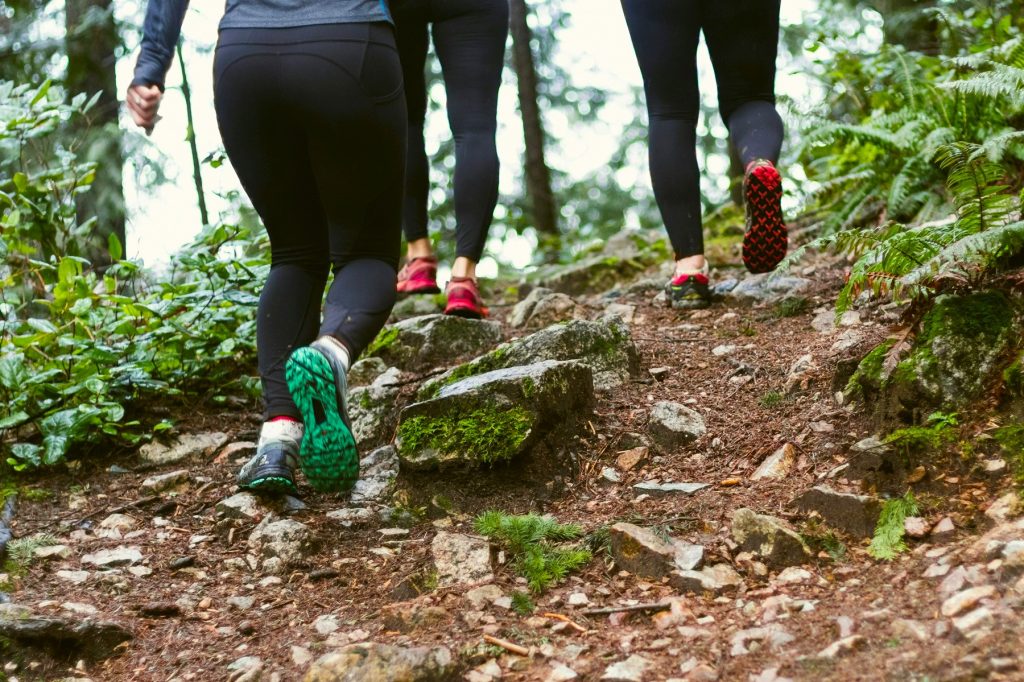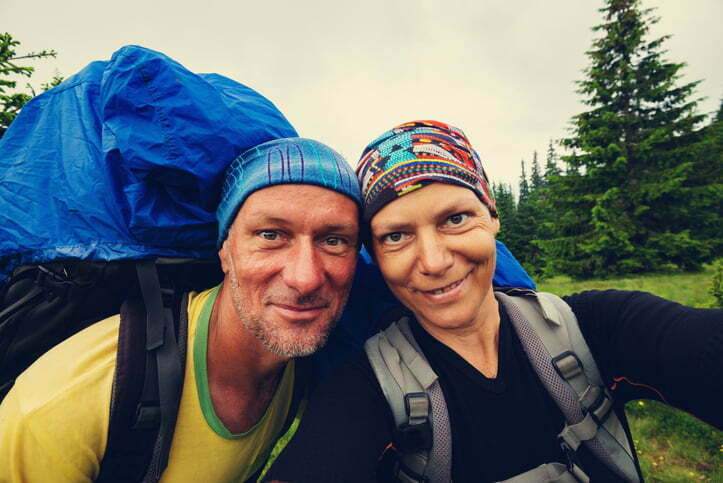Training Ideas For Your Adventure
Our trips cover a number of varying fitness levels (we understand that it’s never as simple as one size fits all), starting from a base level achievable for pretty much everyone, all the time.
Others, they’re a little more challenge, so some will simply be able to look forward to it at their normal fitness level, whilst for others, it may require a little dedicated training.
Both approaches are perfectly fine, and simply reflect how different we all are!
Fitness
All trekkers, climbers and paddlers must make special efforts to get in top physical condition for the trip they have signed up for. Every participant should consult a physician well before the expedition date and make sure that they do not suffer from any chronic heart, lung, cerebral, physical, or any other serious illness.
As your service provider and hosts, we will take all necessary steps needed to evacuate injured or ill clients on the understanding that all costs involved will be paid to us before leaving the country.
Emergency Medical Evacuation Insurance is a requirement for all guests travelling on our expeditions.
If you have not arranged your insurance yet, please contact our office directly, via phone or email, to obtain an insurance quote.
The following is a basic training regime for the next few months. You do not need to be superman to complete the expedition but the fitter you are the more enjoyable you will find it. All members should be either walking or jogging everyday, where possible. Resistance and endurance training (i.e.: stair climbing, hills, inclines and anything that goes in the upward direction). At least 1/2 an hour per day should be a minimum.
To make jogging / walking interesting try the local parks or the odd mountain or three. Also invite a friend along, that way both of you will benefit from the exercise and you have someone to talk to.
Upper body strength is also important. A person with overall muscle tone is going to be far better off than someone who has sculpted their body for aesthetics. For those without access to gyms, pushups and sit-ups and chin-ups are excellent. All can be done at home or when you are out jogging.
Below is a small exercise regime, which will condition and tone muscle groups necessary to enable you to cope with the rigors of any rugged terrain.
Sit-ups: repetitions of 20 daily – increasing by 5 at the beginning of each week – max level 50
Pushups: repetitions of 10 daily – increasing by 5 at the beginning of each week – max level 100
Chin-ups: repetitions of 5 daily – increasing by 5 at the beginning of each week – max level 30
If you have a gym at your disposal then aerobic exercise, boxercise and the like are all excellent ways to increase your oxygen intake capacity and muscle fitness. Swimming is a low-impact exercise but has the same benefits as aerobic exercise. If you don’t like to perspire then give swimming a try.
The secret is to do exercises that simulate what the expedition will be like, so hiking with a pack up and down hills for a few hours is ideal. We all have busy lifestyles so if this is not possible, a hike into the hills every 2 or 3 weeks would be beneficial.
We hope this helps you all enjoy your time on the expedition.
Before you dive into one of the suggested training regimes for your trip, we suggest you check out our Trip Grading Information below if you have not yet done so.
Expedition Grading


Training Hike Suggestions by State
The following are suggested walks of varying difficulty around Australia that will help with your training.
Canberra
Stockyard Spur Day Hike is a 13km hike in Namadgi National Park. This trek takes around 4 hours to complete and has quite a steep incline for the first 2km and then becomes more undulating for the remainder to the summit. This is a grade 4 walk that helps to prepare you for the many steep inclines and declines that you will come across along our mountain treks.
You begin this trek at Corin Dam Car Park.
Sydney
There are plenty of walks around Sydney that are perfect for training. These are a few ideas.
Berowra Waters along the Great North Walk. A very enjoyable and scenic 17 km walk. Together with a few steep climbs the trail is very good.
Blue Mountains at Glenbrook. This is a trek/scramble/bushbash/mountain climb/hike through the Glenbrook Gorge, up the mountain side to Portal Lookout and back along the trails over the Causeway and back to the gates of the National Park. Fantastic scenery along the way. Along the way there are several sections (like creek crossings and rock walls) that will require a bit of teamwork.
Ku-ring-gai National Park. Start at the Gibberong Track Wahroonga and walk down to Bobbin Head. From there walk back up the Bobbin Head track, back down the Sphinx Track and along the Warrimoo Track back to Bobbin Head for lunch. From there walk around to Apple Tree bay and then head out of the park via Birrawanna and Kalkari Tracks. Should take about 5 hours plus lunch. It will mean leaving cars at both Wahroonga and Mount Colah.
Walk from Patonga to Mt Wondabyne Station on the Great North Walk (18 km). It should take about 4 to 5 hours to walk this section. Arrive at Mt Wondabyne Station.
Depending on the time, you can do another return walk from the Station towards Pindar Caves & Pool. This walk return is about 11kms. Catch the train from Wondabyne Station back to Brooklyn. The train leaves on the half-hour every hour.
Meet at the “Explorer’s Tree” in Katoomba. This tree is on the Great Western Highway, on your left just west of Katoomba. Look for Nellies Glen Road on your left. There is parking available. The walk is approx 15.5kms each way. The elevation change is 800m each way. The walk down should take approx 3 1/2 hrs. Plan to spend no more than one hour at Cox’s river for lunch and swim before heading back up. Please bring your cozies and towel if keen for a dip. The walk back up should take 5 to 6 hrs and have you back between 5:30 and 6:30 pm. Be sure to bring plenty of food and drink. Water is available from Cox’s river at the bottom. You will need lots of energy for this walk so it is important to keep eating and drinking along the way.
Cairns
In the north suburbs near the airport and botanical gardens is the “red arrow” walk (45 minutes – up & down) and at the top is the ‘blue arrow’ walk (150 minutes – up & around). Great walk to do with a pack. You can also go on the Green arrow walk to Whitfield.
Up the Redlynch valley is the Crystal Cascades walking track (120 minutes – up & down). In the southern suburbs in Bayview Heights (top of Crest Close) is the Copperlode Dam walking track (200 minutes). At Gordonvale in the south is the Pyramid Mountain walk (380 minutes – up & down). This is the great for mountain trek training.
Townsville
Castle hill is a good track, but is short and can be done several times from different directions with tracks leading onto each other.
Rockhampton
Mt Archer has a good short walk that can be done from several different sides.
Brisbane & Sunshine Coast
The “Hinterland Great Walk” – Maleny to Mapleton. This is 58 km overall but is broken into 5 different circuits you can do. There are ample good climbs for the legs. Great multi day walking.
Mt Cooroora at Pomona (just north of Noosa). The hardest climb but probably not long enough. Walking this twice is a really good training walk. Very steep and challenging with a full pack.
Mt Coolum. This is also an honest climb but a little short and the descent is quite easy. You can walk up from the carpark and there is another trail that goes over the back of the mountain back down. Then walk back up and then walk back down to carpark.
Mt Eerwah has been described by some as “Unrelenting but rewarding” with a steep and loose track, definitely not suited for those with balance issues. 3 to 4 hours as a round trip, the word ‘eerwah’ is apparently the indigenous word for ‘death adder’. So watch out!
Glasshouse Mountains – There are plenty of walks out there, such as Mt Tibrogargan. You can do a fairly basic long-distance walk before a steep ascent up the mountain. The climb has rough and unstable terrain. This is a good hike to prep for Kokoda as it sort of mirrors some of the stuff in PNG.
Within Caloundra, there is a boardwalk (mostly flat) that stretches for miles in both directions.
Gold Coast Hinterland
Springbrook National Park
Mt Cougal and Springbrook pinnacle are good walks for Kokoda.
Adelaide
Waterfall Gully to Mt Lofty is a good start; twice up and down in around 200 minutes. The “goat track” up Chambers Gully is a great option to replicate rugged, mountain terrain. About 15 minutes up; its narrow and very steep. 3 times up and down or a couple up and then along Long Ridge to Mt Lofty summit and back is a good work out.
Another great walk is the Onkaparinga Gorge Loop Trail and Lookout, Sundews Ridge Hike. It’s a Grade 3 Moderate walk for about 2 hours but you can extend it onto other Tracks.
Click below to a link that explains this walk and other great walks in South Australia.
Melbourne
There are several good walks around Melbourne for training.
In the Dandenongs are the 1000 Steps (45 mins up and back) at Upper Ferntree Gully and the Glasgow Track (45 minutes up and back) at the end of Glasgow Rd in Montrose.
Other more out of town walks are the You Yangs (2-3hrs walking) out of Geelong, Mt Macedon (2-4 hrs walking) north of Melbourne, Mt Martha (2-3hrs walking) on the Mornington Peninsula and Mt Donna Buang (5hrs walking) near Warburton. The last one is only 1 to 1.5 hrs from Melbourne.

If you already have a frequent training regime, have a higher-than-average fitness level, and already have a few hikes under your belt, check out our Self-Guided Training Program.
Being part of the No Roads Family also gives you access to our On-Demand Trekking Preparation Program, exclusively curated by one of our Guides and Personal Trainers to get you in perfect shape for your trip, at a special discounted rate.


